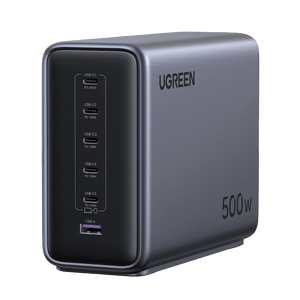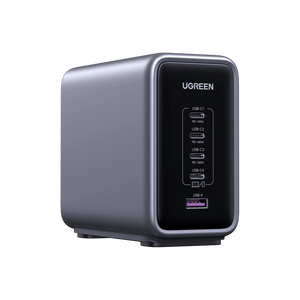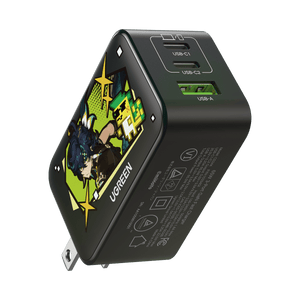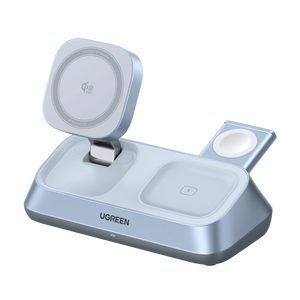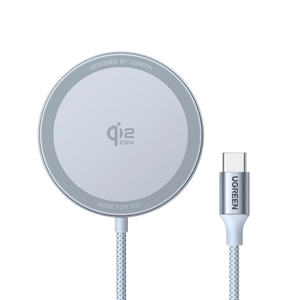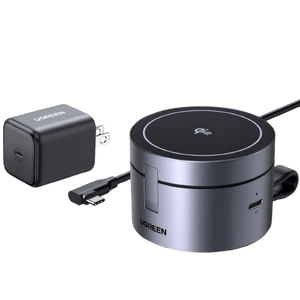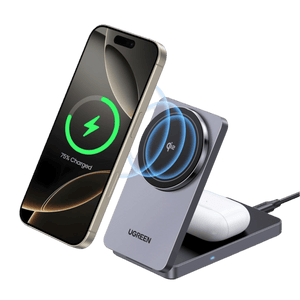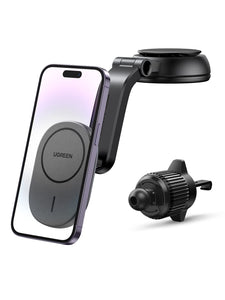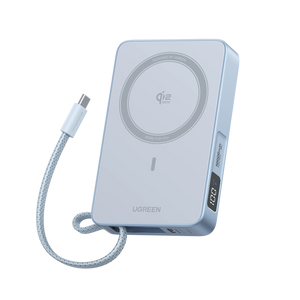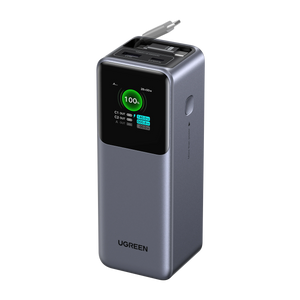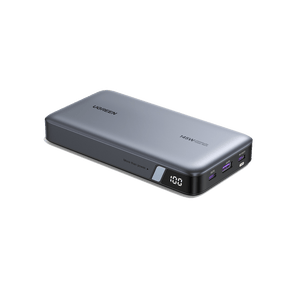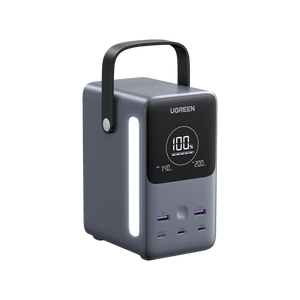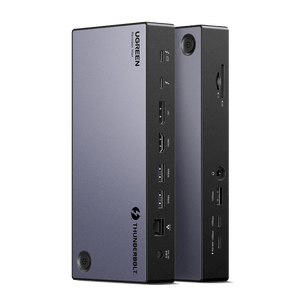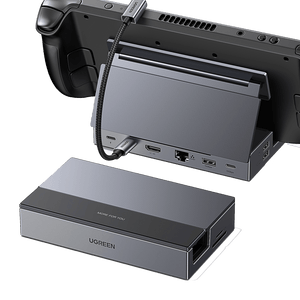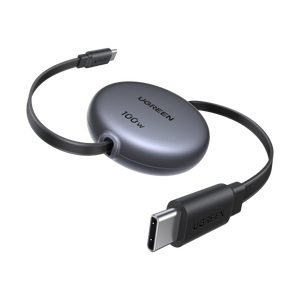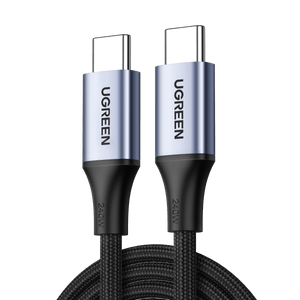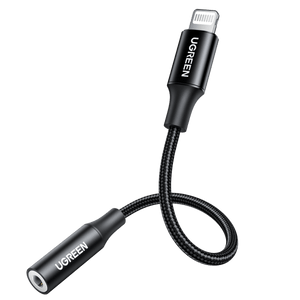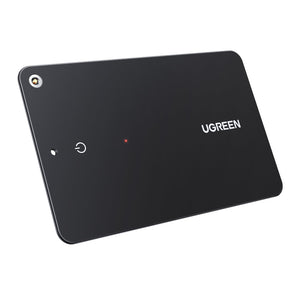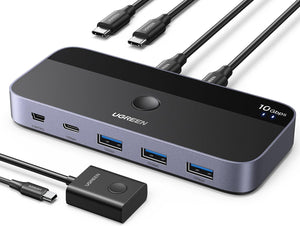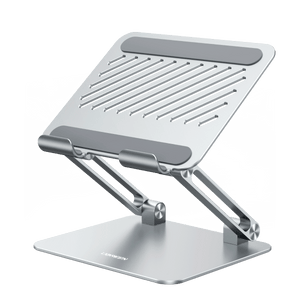[MAKE USE OF]Ugreen PowerRoam 1200 and SC200 Solar Panels: Stellar Mid-Size Portable Backup Battery
Note: The article was originally published on www.makeuseof.com and was written by James Bruce. To access the original article, click here.
App connectivity, long-lasting LFP cells, and great value make this an almost perfect 1024Wh power station and solar combo.
The PowerRoam 1200 is almost perfect as a mid-size portable battery—the only downside being that the carry-handle doesn't fold over, and there's no Qi charging pad. It can power AC continuously up to 1200W (or some higher-powered appliances in UTurbo mode), along with a selection of high-power USB ports, and a built-in emergency lighting system. App control over Bluetooth or Wi-Fi rounds out this great value battery.
The SC200 panels, of which you can pair a maximum of two with the PowerRoam 1200 to charge in around 4 hours, are well-designed and include an angle guide to help you get optimal output. Unfortunately, a little power is wasted when connected to the battery using the included Y-splitter cabling, and out of the box you can't do series wiring for full efficiency.
SPECIFICATIONS
- Brand: UGREEN
- Weight: 11kg (25.4lbs)
- Size: 340 x 220 x 270 mm (13.4 x 8.7 x 10.6 inches)
- Capacity: 1024Wh Maximum
- Discharge: 1200W continuous, 3000W surge (and capable of powering certain high power devices up to 2500W in UTurbo mode)
- Input: 400W solar (XT60), 500W AC
- Lifecycles: 3000 to 80%
- Battery Type: LFP (Lithium iron phosphate) Solar Charging: 400W max, 12-48V@15A
- Cost per Wh: $0.80
- AC outputs: 2 x AC
- USB outputs: 2 x USB-C 100W, 2 x USB-A 22.5W
- Other outputs: 12 car port and 2 x DC
PROS
- ✅Long lasting LFP battery cell
- ✅0% emergency mode enables lighting and USB sockets even at 0% battery remaining
- ✅Angle guide on the SC200 solar panels helps with positioning panels for optimal performance
- ✅Comprehensive app control via Bluetooth or Wi-Fi
- ✅Fantastic value
- ✅UTurbo mode for higher powered appliances
CONS
- 🟥The 1200 part of the name is the power output, not capacity
- 🟥No Qi wireless charging pad
- 🟥Power wasted when connected to two SC200 panels using the included connectors
- 🟥Reversed polarity on the XT60 to MC4 cabling provided with the panels may cause confusion
Ugreen is a fairly well-known household name when it comes to chargers, cables, and USB hubs. But, to my knowledge, they haven't tackled power stations or solar before. It's always good to see some innovative competition in this space.
Today, we're looking at the new Ugreen PowerRoam 1200, combined with two of their SC200 portable solar panels. I've been impressed both in terms of performance and value of the power station, but with a few niggles. The solar panels are outstanding though, and have quickly become my favorite portable panels to take everywhere.
PowerRoam "1200" Power Output
My first and only actual complaint with the Ugreen battery is the name. Most manufacturers name their device models after the capacity. So, if you put 1200 in the name, I'd expect around 1200Wh of capacity. Not so in this case, and it feels a little deceptive. In fact, 1200 is the total power output possible (1200W), while the capacity is slightly smaller at 1024Wh. Now, that's still a respectable amount of power, but it does make it a little harder for less knowledgeable consumers to compare batteries.
Since we're talking about specs anyway, I'll also mention that the surge output is an impressive 3000W, and the continuous 1200W should be enough for a travel kettle or most household appliances, just not a full-size kettle. It was enough for our induction hob to cook breakfast though, and that's the highest draw of appliance we'd use in an emergency.
However, if you do want to use even higher-powered devices, it employs a technology they call U-Turbo to allow devices that use up 2500W. This works by lowering the voltage, even though the total power drawn stays under the limit, so if you try with a larger kettle for instance, it'll boil maybe half as fast. It's worth noting this won't work with all devices; it's mostly just inductive load things like big heating elements or large motors that can be run like that. But that's a useful feature where applicable.
It also has another trick up its sleeve, and that's what they call 0% battery emergency mode. This appears to be a reserve supply, so once it reaches 0%, it'll still let you run the built-in light and charge your phone for up to 7 hours. Hopefully, you never get desperate enough to use that, but it's peace of mind.
In terms of output, there are two AC sockets a 12V car socket and DC ports.
For USB, we have an impressive two 100W USB-C PD and two USB-A ports running at up to 22.5W, which is excellent. Typically, those will only go up to 18W, so that's a bit of extra juice.
Most portable batteries also only feature a single USB-C PD, so this is pretty generous on that front, with plenty of smartphone and laptop charging possible. Given the 1200W limit or U-Turbo mode for one appliance, the two AC ports are more than enough on a battery of this size. It's also worth noting that the USB ports don't need to be turned on; they're automatically activated. The DC button only controls the car output set over here. However, there’s no Qi wireless charger if that’s important to you.
Portability
As for size and weight, at 340 x 220 x 270 mm and 11kg (13.4 x 8.7 x 10.6 inches and 25.4 pounds), it's as compact and lightweight as you could expect from a battery of this size. For instance, the Jackery Explorer Pro 1000 is exactly the same weight and ever so slightly larger. You can find 1000Wh batteries under 10kg, however, those use lithium-ion rather than lithium iron phosphate (LFP) cells. Lithium-ion has a significantly reduced lifespan—around 500 full cycles compared to 3000 cycles of LFP before degradation.
Either way, you can carry it comfortably in one hand, but not very far because 11kg is still pretty unwieldy. The handle is fixed, which for stowing in your trunk can be a little annoying.
As for design, it’s pretty demure with no bold orange colors, just dark and light grey. Also worth mentioning, you get a handy cable case included for the AC cable, car cable, XT60 Y splitter, and DC-to-DC cabling.
Charging
To charge over AC, you just need an IEC cable, and you can get up to 80% of capacity power in 1.5 hours. This is something they tout on their sales page as remarkable technology they call "PowerZip," but actually, that works out at about a 500W charge rate and isn't really that remarkable. You can find charge rates up to 2400W on other batteries, albeit bigger ones. It's not bad by any means, but it's certainly not something I'd give a special name and claim to be 5.3X faster than everyone else. That may have been true of the last generation of portable batteries, but it's nothing special now.
There’s no external power brick needed, which is both great in terms of fewer accessories to lose and for overall convenience. However, it’s not magic, of course. It just means that the power brick is integrated into the unit, making it slightly heavier than competitors that don't do that, but only by a tiny margin.
You can also charge via a car battery (with protection so it doesn't kill it by charging too much), and up to 400W over solar (12-48V, 15A), via the separate XT60 input port.
App Control
Featuring IoT connectivity via Wi-Fi or Bluetooth, the Ugreen app offers a comprehensive set of settings and features.
While I managed to connect it over Wi-Fi, it seemed to have issues roaming between my access points. That's probably the fault of my infrastructure rather than a Ugreen problem, so I won't ding it for that. But you'll need the app if you want to enable U-Turbo mode.
It's also nice to see granular output stats for every USB port, and you can even toggle the lighting feature on or off directly from the app, without having to press the one physical button to cycle through modes. So, the app offers everything I'd want from a portable battery app in a clean and easy-to-understand interface. Big tick there.
SC200 Solar Panel
The Ugreen SC200 (200W) solar panels are without a doubt the best portable solar panels I've come across yet, but with one annoying caveat: they provide the wrong cables. I'll explain more in a moment.
The SC200 are briefcase-style panels with a built-in solid plastic handle, which is very convenient and avoids having to provide a separate carry-case. The rear stand on the back of each panel is secured with a magnetic clasp, so no fumbling around to unclip them. Folded, they measure 57 x 54 x 51cm, and weigh around 8.4kg (22.6 x 21.3 x 20 inches, 18.8lbs).
One really neat feature I want to point out is the angle guide, which I've not seen built into a panel before. It's a small piece of clear plastic with a dot in the middle, and underneath, there's a little cavity into which the dot projects. There's a circle labeled in the center. It's a straightforward idea: get the projected dot inside that circle for maximum output, because that's where you'll be 90 degrees to the sun.
I set the panels up as I always do and found that I was a bit off. By tweaking the angle so it was perfectly lined up at the center, I added another 10-20W to the output from a single panel. So, even if you think you're angling it right, this feature can be handy.
Another cool feature, which unfortunately may also be confusing for some, is that the cabling isn’t built-in. Instead, you'll find an XT60 socket underneath a rubber cover on the rear. This is an interesting design choice because it means you can use a straight-through XT60 to XT60 cable for ease of connection, and you can replace broken cables cheaply an d without fuss. With portable panels, it's easy to forget something is plugged in or snag the cabling when folding them up.
Once optimized with the angle guide, I found the output from a single panel to be outstanding, with a maximum of 150 watts during our springtime morning sun.
However, when I connected them in parallel using the supplied Y adaptor cable that came with the battery, I only got 250W—rather than double that of a single panel, which would have been 300W. So, somewhere along the line, 50W is mysteriously disappearing.
This is easy to explain if we look at the electrical specifications of the panels. The solar input on the battery is rated at 12-48V, 15A maximum. Each panel operates at 16V and around 9A at the time of this test. By using the supplied parallel connector cable (a Y-shape), we combine the current (A), resulting in an input of 16V 18A, which is above the maximum 15A input by about 3A. And three times 16V gives us the missing 50W. This overcurrent doesn't break the charging circuit but ultimately limits the power we can use. So, if you use the cable provided, you're wasting potentially 50W or more.
Instead, we should combine voltages using a series circuit, where one panel feeds into another, then the positive from one panel and negative from another go to the battery. Out of the box, this isn't possible, and when I mentioned this to Ugreen, they said they would be providing another cable in the battery box to help with that. Unfortunately, that still wouldn't allow you to do this, as I'll discuss later.
I should also mention that this issue of mysteriously disappearing power isn't a unique problem to Ugreen. I had the same issue with Jackery panels before. While individually very efficient, collectively they don't perform as well and tend to waste power. It's always a good idea for you to know the power output of your panels, the open circuit voltage, the current, as well as your battery input ranges. It's okay to exceed current; you’ll just be limited, but generally not voltage. That's more likely to cause damage.
Lastly, we need to talk about polarity of the supplied MC4 cables, because it's sort of wrong depending on which angle you look from. Essentially, it stems from the fact that both the battery and the panels use an XT60 connector.
As well as an XT60 to XT60 cable for directly connecting the panels to the battery, Ugreen supplies an MC4 to XT60 cable in the solar panel box. In theory, this should allow you to plug it in to the socket on the panels and get the same standard MC4 tails that you would get with any other generic solar system. Then you'd be free to charge any other battery from these panels, or to connect them in series (which you can't do with a straight through XT60 cable). Unfortunately, the cable they provide with the panels have reversed polarity. These cables are designed to go on the battery end, allowing you to use MC4 tails from a solar panel into the battery.
It’s widely accepted on solar panels that an MC4 tail will be male plug for positive (the sticky-out bit) and female socket for negative. However, the cable provided is male for negative (black) and female for positive. So, as it is, this is the kind of cable that should have been provided with the battery to enable use with other solar panels, not supplied with the panel to enable use with other batteries. As you can see, simply adding another one of these cables in the battery box wouldn't help.
In the grand scheme of things, this isn’t a huge deal. If you understand solar wiring, you can always create some male-to-male and female-to-female adaptors or just get them off Amazon. But it would indicate that Ugreen didn't fully understand what they were doing here, or attempt to test the series connectivity.
Should You Buy the SC200 Panels and PowerRoam 1200 Battery?
The PowerRoam 1200 battery offers pretty much everything you could want in a midsize battery backup unit, including the ability to power appliances well above average for its size, a comprehensive display, 0% emergency mode, built-in lighting, and plenty of ports. It even has a smartphone app for some of the more complex configurations and remote monitoring. And with a rated 3000 cycles until 80% battery degradation thanks to the lithium iron phosphate (LFP) cells, you could use it every day with a full charge and discharge for around 8 years before it would be degraded to 80% capacity. It's almost perfect, except for the lack of wireless charging pad.
Normally, I'd expect a little premium over the standard $1 per Watt-hour price point for all those features, but in this case, you can actually get it on sale until May 21st as a launch offer for $850. And if you use the code 05UG1200, you'll get another $50 off. That's a fantastic deal for a midsize 1024Wh portable battery. If this is Ugreen's first entry, I look forward to seeing what's next.
As for the SC200 panels, cabling issues aside, they are also superb in terms of efficiency, portability, and that nifty little angle guide feature. They're my new favorite portable panels, but be prepared to learn solar wiring if you want to get the absolute best performance. Two SC200s is the maximum you can plug into the PowerRoam 1200 battery, and, to be honest, that's sufficient. It'll get you charged in four to eight hours, depending on conditions, of course.
At $450 per 200W panel, they align with similar offerings such as those from Bluetti. But there are cheaper, unknown-brand portable panels out there for as low as $250. The only other foldable 200W panel I've tried is nowhere near as efficient as these, so the SC200 would be my pick, for sure.
As always, remember you pay a premium for portability when it comes to solar generation. If you can get away with a 400W static panel on the roof of your cabin, it'll cost about a third of the price of these for the same equivalent power output. So, do consider if you need that portability. They're only really suitable for camping, or if you're not permitted to modify your building structure.



